
Home » The Role of a Paraprofessional in Special Education

The Role of a Paraprofessional in Special Education
Special education has evolved tremendously over the last several decades, and that evolution has sparked the need for more professionals who can provide specific services to classroom students.
A paraprofessional is one of those roles that is somewhat recent with roots in the 1960s . Still, these educators are pivotal to today’s general and special education classrooms, allowing students to communicate, learn, and thrive in their school environment.
As a parent, you might be interested in understanding what paraprofessionals do and the role they play in your child’s classroom. I’ve compiled a helpful guide to introduce you to the paraprofessional role and dive into the many tasks they tackle each day.
A Guide to the Role of a Paraprofessional
What is a paraprofessional in special education, what does a paraprofessional help with, common tasks for paraprofessionals, the vital role of the paraprofessional.
Some schools swap the term paraprofessional for instructional aide, teachers assistants, or another title. Paraprofessional refers to educators who are not certified teachers but provide assistance to students in the classroom.
Paraprofessionals are not only found in special education, but schools use them frequently in this field. These professionals support a general or special education teacher with multiple classroom tasks, ensuring that each student is able to learn to the best of their ability. As such, the paraprofessional typically gets assigned to a classroom rather than one student or group of students. In unique circumstances, a paraprofessional may be assigned to one student if the need is indicated in the student’s IEP .
In a special education classroom, the paraprofessional provides both individualized and group support to students. It’s the paraprofessional’s responsibility to follow through with the lead teacher’s lesson plans and activities, offering help to students, as needed, to complete assignments and understand instruction. The paraprofessional also helps teachers prepare for the day by organizing lesson plans and activities.
Although paraprofessionals are not required to have teaching certification or licensure, they’re an integral part of the education system, especially the special education system. Teachers and students in special education rely on their extra set of hands, eyes, ears, and ideas to manage and support their classrooms.
The responsibilities of a paraprofessional can change from day to day based on what their specific classroom, teacher, and students need. They may provide support in each of the following areas:
Teacher Aid
One of the most important ways that paraprofessionals assist the classroom is by helping the special education teacher. The paraprofessional offers a hand in organizing and preparing materials for the day, going over IEPs and 504 plans to ensure that progress is being made toward goals, and setting up the classroom for productivity.
While the teacher instructs students through lessons, the paraprofessional may work with a small group of students who need extra help. They also walk around the classroom to assist students in assignment completion or test-taking. The paraprofessional and teacher together act as a team to offer as much support to students as possible, also allowing the teacher to focus on their primary responsibilities.
Educational Aid
A paraprofessional supports the classroom, and their support often goes to students who need extra help with assignments, tests, or understanding instruction. Paraprofessionals may oversee students during tests, offer additional instruction after the teacher completes their lesson, or help a group of students who need reading support complete their assignment.
As an educational assistant, the paraprofessional may also, under the guidance of the teacher, tweak lessons or activities for students with an IEP who need modifications or to work on a specific goal. Paraprofessionals in special education may spend some time each day working individually with students while the rest of the day is reserved for the classroom’s educational support.
Physical Aid
A special education classroom may have students with physical disabilities who need help moving from one area of the classroom to another, sitting up, eating, or writing. A paraprofessional can assist with physical tasks so that the teacher can focus on instruction.
Safety is a priority for paraprofessionals in this area. Paraprofessionals keep an eye on students with physical disabilities to ensure that they’re safe and secure at all times, especially when using medical equipment. But they also must have a clear understanding of how to use the child’s special equipment and what the student’s physical needs are to assist them safely.
Behavioral Aid
Classrooms including students with behavioral needs can benefit from a paraprofessional’s extra set of hands, eyes, and ears. Paraprofessionals often become secondary observers in the classroom to keep students on task and prevent potential safety issues. They also might work with students with behavioral needs separately on some tasks that typically trigger specific behaviors from the student when in the usual classroom setting.
Paraprofessionals complete numerous tasks in the classroom by helping the teacher and students. Here, I detail the different kinds of tasks you might expect a paraprofessional to do in the classroom.
Paraprofessionals start most days by observing the classroom and students. Observance includes meeting with the teacher, reviewing the plan for the day, and learning what the teacher expects help with. The paraprofessional may also walk around to gauge the classroom climate and determine what students may need assistance with specific tasks.
Here are a few examples of paraprofessional observance tasks:
- The paraprofessional sees a group of students reading together and sits nearby with a notepad to jot down some questions to ask when they’re finished.
- During a classroom assignment, the paraprofessional sees a student having difficulty writing the letters “b” and “d” facing the right direction and reports the observation to the teacher.
- The paraprofessional circles the room during a period of test-taking to ensure that students stay on task.
- After working one-on-one with a student on an IEP math goal, the paraprofessional reports on the child’s progress to the teacher.
Supportive tasks consume most of a paraprofessional’s day. These are the tasks where the paraprofessional physically assists the teacher and students with classwork, projects, and other tasks. Supportive tasks also include those that support the classroom as a whole, such as organizing activity bins for the following day or adding labels to classroom items and furniture.
These tasks can vary greatly with each classroom, teacher, and student. Here are some examples:
- After showing a shoe-tying video to a student, they tie their laces with little help. Then, the paraprofessional offers reinforcement.
- The paraprofessional assists students with a classroom project while the teacher finishes a child’s evaluation.
- Before class begins each day, the paraprofessional reminds students of the classroom expectations.
- A student arrives at school with a note from a parent saying that they struggled with their homework the previous night. The paraprofessional reads a book to the class while the teacher spends one-on-one time with the student reviewing the lesson from yesterday.
Communication
Paraprofessionals also assist in bridging communication gaps between teachers, students, schools, and parents or guardians. As an extra person in a classroom, the paraprofessional can ensure that each person is on the same page. Here’s how that might look in the classroom:
- The paraprofessional may attend a child’s IEP meeting with the special education teacher to provide extra insight.
- During instructional time, the paraprofessional walks around the room to ask if students have any additional questions or explain anything they don’t understand.
- A paraprofessional with knowledge of a specific language, like Spanish or American Sign Language, interprets for English language learners or students hard-of-hearing.
- After a student completes their classroom assignment within the allotted time frame, the paraprofessional responds with reinforcement.
Virtual vs. Traditional Classrooms
Today’s modern classrooms look different than they did in the past. With some special education classrooms going virtual, the paraprofessional’s tasks remain the same, but the way the aide executes them can vary.
For instance, supportive tasks can be pretty challenging in a virtual classroom setting. Paraprofessionals can adapt by assisting learners one-on-one or in groups in breakout sessions. They also might provide help to students and families by gathering and offering digital resources or assist teachers with preparing digital resources and assignments for learners.
For some paraprofessionals, attending special education conferences and webinars could provide helpful skills for assisting in virtual classrooms.
Paraprofessionals are arguably some of the most integral people in the special education system. Not only do they provide an incredible amount of support to learners, but they also assist teachers, schools, parents and guardians, and the special education classroom as a whole.
Have you thought about becoming a paraprofessional (people experienced with kids in the special education system often make the best ones!). Perhaps you would like to learn more about the pathway taken to enter this role? If so, explore my guide to becoming a paraprofessional in special education.
If you have any questions or would like to talk about a fantastic paraprofessional who you know, please leave a comment below or send me an email!
About the author
Emily Cummings
I am a mom of two crazy, amazing, independent, little feminists. They bring so much light to my life and a lot less sleep. Since becoming a mother and increasingly in the last year, I have witnessed parents struggling to connect with their child's special education team with no success. I have become more aware of the gaps in our public school system and how parents may benefit from empowerment and advocacy tools.
My work experiences range from a juvenile detention center to an autism specialist in the Issaquah School District and a special education teacher in a self-contained program in the Lake Washington School District. My master's in teaching focused on special education and behavioral disorders from Seattle Pacific University. I completed my BCBA coursework from Montana State University.
Want to get in touch?
I'm happy to help however I can. Email me at hello at behaviorist .com.
Understanding the Role and Path to Becoming a Special Education Paraprofessional
You’ve probably heard the term “special education paraprofessional” and wondered what it’s all about. Well, it’s time to clear up the mystery. A special education paraprofessional, also known as a teacher’s aide, plays a crucial role in the educational setting.
They work closely with special education teachers, providing assistance in a variety of ways. From helping with lesson plans to supporting students with disabilities, their role is diverse and rewarding.
So, if you’re passionate about education and have a heart for helping those with special needs, this could be the perfect career path for you. Let’s delve deeper into the world of special education paraprofessionals and discover what they do, their responsibilities, and how you can become one.
What is a Special Education Paraprofessional
Let’s delve deeper into understanding the pivotal role of a special education paraprofessional. They’re integral parts of the special education milieu, often termed as a teacher’s aide . While the terms may seem interchangeable, it’s crucial to understand that a special education paraprofessional has a much more specialized role.
As a paraprofessional, you’d work closely with the special education teachers. Your key responsibilities range from assisting with lesson plans to supporting students with disabilities . This role is crucial in facilitating an inclusive learning environment that promotes academic and socio-emotional growth for students with special needs.
Helping students with different abilities to reach their potential can be both humbling and challenging. As a special education paraprofessional, you’d need to have a knack for understanding diverse learning needs. This requires not just academic knowledge but also patience, empathy, and adaptability. Your role might also entail customized teaching or tutoring, depending on the individual students’ requirements.
Aside from assisting in academic tasks, a special education paraprofessional provides help in non-academic areas too. This might include aiding with physical needs, such as mobility or feeding, and facilitating social interactions among peers. Your presence in the classroom helps create a more personalized, engaging, and supportive space for students with special needs.
Becoming a special education paraprofessional is a rewarding pursuit if you’re passionate about imparting education and advocating for those with special needs. It’s a career path that lets you make a difference, one student at a time.
Indeed, the role of a special education paraprofessional is multi-faceted, extending beyond conventional teaching aid roles. The personal development and specific skills you’ll gain in this profession are undeniable. Your dedication can profoundly impact the lives of students who need that additional support to make their educational journey a successful one.
Roles and Responsibilities of a Special Education Paraprofessional
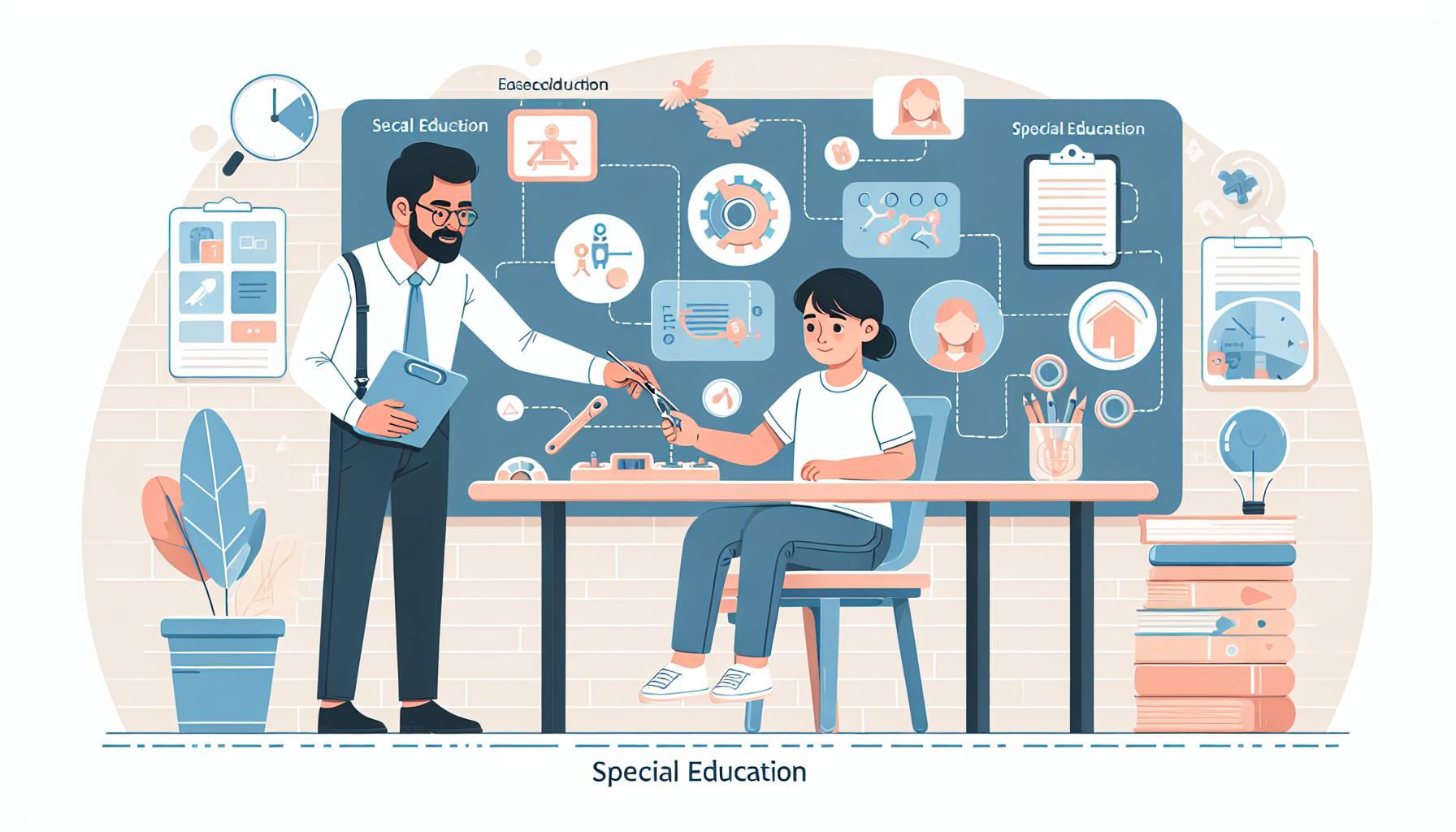
A special education paraprofessional , otherwise known as a teacher’s aide, is absolutely crucial in the educational arena – particularly in facilitating an effective learning environment for special needs students. This role requires a skill-set that blends patience, understanding and adaptability.
The academic tasks they perform include, but aren’t limited to, assisting with lesson plans and grading assignments. A key role you’ll find in their job description is adapting teaching methods and instructional materials to meet students’ varying needs and interests. This includes working side-by-side with teachers to ensure the curriculum and strategies used are student-centered and fitted to diverse learning capabilities.
Beyond merely academic, a special education paraprofessional is involved in non-academic support , which is equally critical. Assisting with physical needs is part of their day-to-day work. Whether it’s helping a physically challenged student navigate the school campus or aiding another student in performing a laboratory experiment, their responsibilities extend far beyond the classroom.
A hugely important aspect of their role is nurturing the social development of these students. Through fostering an environment that encourages interaction and collaboration, they assist in building students’ social skills. This includes facilitating social interactions, fostering positive relationships with peers, and helping students become integrated into the wider school community.
So, you may ask what does it take to be a special education paraprofessional? Patience, empathy and creativity, are among the core skills. As you embark on this career path, you’ll find it highly rewarding, because it’s not just a job – it’s an opportunity to create meaningful change in the lives of students with special needs. There’s no denying the profound impact a paraprofessional can have on a student’s educational journey.
In essence, a special education paraprofessional does more than meet the eye. This important role bridges the gap between can’t and can, potential and reality. It’s about inclusion, engagement and equipping our students for success in and out of the classroom.
Importance of Special Education Paraprofessionals in the Education Setting
Special education paraprofessionals, commonly known as teacher’s aides, hold a unique and critical role in the educational domain. They are the linchpins who ensure the smooth functioning of an inclusive classroom.
Their key responsibilities extend far and wide, providing vital support to the teaching staff and students. Let’s delve deeper to understand further why special education paraprofessionals are quintessential in any educational setting.
Enabling Individualized Attention
In a diversified classroom environment with students having varying needs, it is not always possible for a teacher to cater to everyone’s unique requirements. That’s where special education paraprofessionals step in. They help bridge this gap by offering individualized attention and support to students, ensuring their specific educational needs are met.
Paraprofessionals adapt teaching strategies, modify lesson plans and tailor teaching materials to suit the capabilities and understanding levels of each student. They work in tandem with special education teachers to guarantee that every student’s learning curve is addressed.
Supporting Physical and Social Development
Beyond academics, special education paraprofessionals also assist students with physical needs. They facilitate social interactions among students, thus bolstering their social skills.
These professionals support students in various physical tasks such as eating, using the restroom, and navigating the school environment. Their role in promoting social development is also commendable. By interacting with students, coordinating group activities and encouraging peer interactions, they cultivate an atmosphere conducive to social learning.
Nurturing Patience and Empathy
The work of special education paraprofessionals isn’t just beneficial—it’s necessary. Their patience, empathy, and creativity in dealing with students having special needs are characteristics that are in high demand in today’s educational scenario. Much like the diverse colors in a palette , these professionals bring a variety of strategies and perspectives to the educational landscape, enriching it immensely.
Their valuable contribution to constructing an inclusive, engaging, and productive learning environment can’t be overstated. The assistance they provide helps equip students for success not just within the classroom, but beyond it as well. Success that positively impacts students’ lives, contributing to their all-around development. It’s akin to nurturing trees in a garden , ensuring they grow strong and resilient, capable of withstanding the challenges they face.
Indeed, the importance of special education paraprofessionals extends far beyond grading assignments and aiding in lessons. Their impact is profound and far-reaching, echoing throughout classrooms and the lives of students, creating ripples of positive change. Like the calm waters of lakes reflecting the beauty of their surroundings, these educators mirror the potential and value of every student, encouraging them to reach their fullest. Whether it’s through the structured learning environment akin to the clear waters of pools or the casual interaction during a school event as relaxed as grilling by a lakeside , their influence fosters a nurturing and supportive atmosphere where all students can thrive.
How to Become a Special Education Paraprofessional
If you’re looking to make a difference in a child’s life, becoming a Special Education Paraprofessional might be your calling. From assisting students with diverse needs to promoting an inclusive learning environment, this career path requires commitment and passion.
To become one, a high school diploma is the essential first step. Employers expect this basic educational requirement. However, many schools and educational institutions may require additional qualifications such as an associate degree or a certificate in special education.
Further, paraprofessionals often complete training modules that equip them with the needed skills to work with students with diverse needs. Some employers provide on-the-job training, right after you’re hired.
However, going that extra mile, gaining a degree in subjects like special education, child development, or psychology could greatly enhance your employability potential.
| Education Level | Typical Study Areas |
|---|---|
| High school | Mandatory |
| Associate degree | Special Education, Child Development |
| Training | On-the-job (provided by many employers) |
Besides academic qualifications, you’ll need to display a certain set of skills and traits to excel in this role.
- Patience and empathy are paramount, as you’re dealing with students with diverse needs.
- A flair for creating engaging learning materials can have a significant impact on student outcomes.
- Being able to adapt to the unique needs and learning styles of each student is a must.
While this roadmap provides the educational and skill requirements to become a special education paraprofessional, remember that every individual and learning environment is different. Experience is invaluable, and gaining hands-on experience through internships or volunteering at special needs schools or community programs can help you understand the practical nuances of the job. As you progress through your journey, keep an open mind, continuously learning, and adapting to enhance your effectiveness.
Every step you take towards becoming a Special Education Paraprofessional brings you closer to making a meaningful impact on a child’s life. Step forward, and see the difference you can make.
So, you’ve seen how vital special education paraprofessionals are in shaping the lives of students with diverse needs. The role requires a blend of patience, empathy, and creativity, and while the educational bar is set at a high school diploma, further qualifications can boost your career prospects. Whether you opt for on-the-job training or pursue a degree in a related field, remember that hands-on experience is key. It’s not just about landing the job; it’s about making a real difference. As a special education paraprofessional, you have the power to positively influence a child’s educational journey. It’s a challenging yet rewarding career path that’s worth considering if you’re passionate about inclusive education.
What is a special education paraprofessional?
Special education paraprofessionals are support staff in educational settings who assist teachers in implementing special education programs. They play a crucial role in helping students with diverse needs to meet their educational goals.
What qualities are needed for a special education paraprofessional?
Patience, empathy, and creativity are essential qualities for a special education paraprofessional. Being able to understand and adapt to diverse students’ needs will greatly aid in this role.
What are the educational requirements to become a special education paraprofessional?
A high school diploma is the basic qualification needed. However, having additional special education qualifications can enhance chances of employability. Some places might offer on-the-job training as well.
Can a degree in special education, child development, or psychology help with a career as a paraprofessional?
Yes, a degree in special education, child development, or psychology can not only enhance employability but also give a deeper understanding of child development, learning strategies, and behavioral aspects.
Is hands-on experience important for a special education paraprofessional?
Hands-on experience provides an understanding of the practical aspects of the job. Internships or volunteering can provide these experiences and can be invaluable when starting your career in special education.
Related Posts
The role of the special education teacher, special education certification texas.
- Technical Support
- Find My Rep
You are here
The Paraprofessional's Essential Guide to Inclusive Education
- Peggy A. Hammeken
- Description
"A well-designed reference and learning tool for paraprofessionals. The valuable templates can easily be reproduced and used with students." —Renee Bernhardt, Special Education Teacher Johnston Elementary School, Woodstock, GA
"This is a great guide. I have already used excerpts for an informal paraprofessional workshop in my school. The paraeducators thought that it covered all the areas of concern that they have. They couldn't believe how many ready-to-use ideas it had." —Dawne Dragonetti, Special Education Teacher and Instructional Coach Center School, Stow, MA
Hundreds of strategies that promote success for struggling students in inclusive classrooms!
Paraprofessionals are essential in helping students with special needs access the general education curriculum and receive the individualized attention they need. This updated edition of Inclusion: An Essential Guide for the Paraprofessional answers paraprofessionals' most common questions and provides extensive strategies for all content areas.
Developed as a daily, hands-on working manual, the completely revised edition includes a new chapter on reading, expanded chapters throughout, additional activities for classroom use, more than 75 new strategies, and more than 50 forms available on a CD-ROM for easy reproduction. Ideal for experienced or novice paraprofessionals, this volume includes techniques for supporting students in reading, spelling, language, and mathematics, and covers topics such as:
- Inclusive practices
- Policies, procedures, and schedules
- Accommodations and modifications for the classroom
- Communication and organizational skills
- Peer tutoring
- Behavior management
- Confidentiality and reporting
Also an appropriate handbook for working with general education students who may need additional help to experience academic success, this resource provides the ideal support for all paraprofessionals working in the general education classroom.
| ISBN: 9781412966115 | Paperback w/CD | Suggested Retail Price: $44.95 | Bookstore Price: $35.96 |
See what’s new to this edition by selecting the Features tab on this page. Should you need additional information or have questions regarding the HEOA information provided for this title, including what is new to this edition, please email [email protected] . Please include your name, contact information, and the name of the title for which you would like more information. For information on the HEOA, please go to http://ed.gov/policy/highered/leg/hea08/index.html .
For assistance with your order: Please email us at [email protected] or connect with your SAGE representative.
SAGE 2455 Teller Road Thousand Oaks, CA 91320 www.sagepub.com
"A well-designed reference and learning tool for paraprofessionals. Many of the suggestions, examples, and vignettes could be applied to general educations students as well as those with disabilities. The valuable templates can easily be reproduced and used with students."
“This is a great guide. I have already used excerpts for an informal paraprofessional workshop in my school. The paraeducators thought that it covered all the areas of concern that they have. They couldn’t believe how many ready-to-use ideas it had and felt that the appendix alone was worth the price.”
"Hammeken has provided an invaluable tool for paraprofessionals, school administrators, and teachers, both general and special. This book is a goldmine of information."
"I highly recommend this for paraeducators, special and general education teachers, and problem-solving teams looking for things to try for students. Get many copies!"
- Over 400 strategies for working with students with special needs in an inclusive classroom or resource room setting
- A brand-new chapter on reading with specific strategies and material to enhance student support in the areas of decoding, comprehension, and vocabulary development, along with new supplemental forms.
- Updated discussion of special education legislation
Appendix and CD includes over 50 reproducible forms to help with communication, planning, documentation, supplemental student aids, and more!
Preview this book
Sample materials & chapters.
Chapter 1: Building Background
Select a Purchasing Option
Related products.

404 - NotFound
The resource you have requested cannot be found.
We're sorry :-(

Professional Development for Paraprofessionals on Inclusive Practices using Disability Studies in Education
- Michelle Damiani Rowan University
- Casey Woodfield Rowan University https://orcid.org/0000-0001-5545-055X
- Brent Elder Rowan University https://orcid.org/0000-0003-2638-6143
- Justin Freedman https://orcid.org/0000-0003-0598-9586
Paraprofessionals serve a critically significant role on educational teams, yet often receive the least amount of training among educational professionals. This article details an online paraprofessional learning series created by a team of special education faculty. The professional development series draws on a disability studies in education (DSE) approach and high leverage practices to situate paraprofessionals as active contributors to inclusion as a social justice imperative. Aligned to the Council for Exceptional Children’s (CEC) Core Competencies for special education paraeducators (2022), topics addressed in the series are: (a) foundations of inclusive education, (b) learner development and characteristics, (c) supporting UDL in the inclusive classroom, (d) supporting specialized instruction for the inclusive classroom, and (e) learning environments and behavior support. We offer research-based strategies to build paraprofessionals capacity for inclusion through a lens of social justice and equity. This article can serve as a resource for paraprofessionals, and a model of bridging research-to-practice for special education faculty and administrators seeking to increase continuity across pre-and in-service teacher preparation and paraprofessional professional development.
Author Biographies
Michelle damiani, rowan university.
Dr. Michelle Damiani is an Assistant Professor of Inclusive Education at Rowan University in the Interdisciplinary and Inclusive Education Department.
Casey Woodfield, Rowan University
Dr. Casey Woodfield is an Assistant Professor of Special Education at Rowan University in the Interdisciplinary and Inclusive Education Department.

Brent Elder, Rowan University
Dr. Brent Elder is an Associate Professor of Special Education at Rowan University in the Interdisciplinary and Inclusive Education Department.
Justin Freedman
Dr. Justin Freedman is an Assistant Professor of Special Education at Rowan University in the Interdisciplinary and Inclusive Education Department.
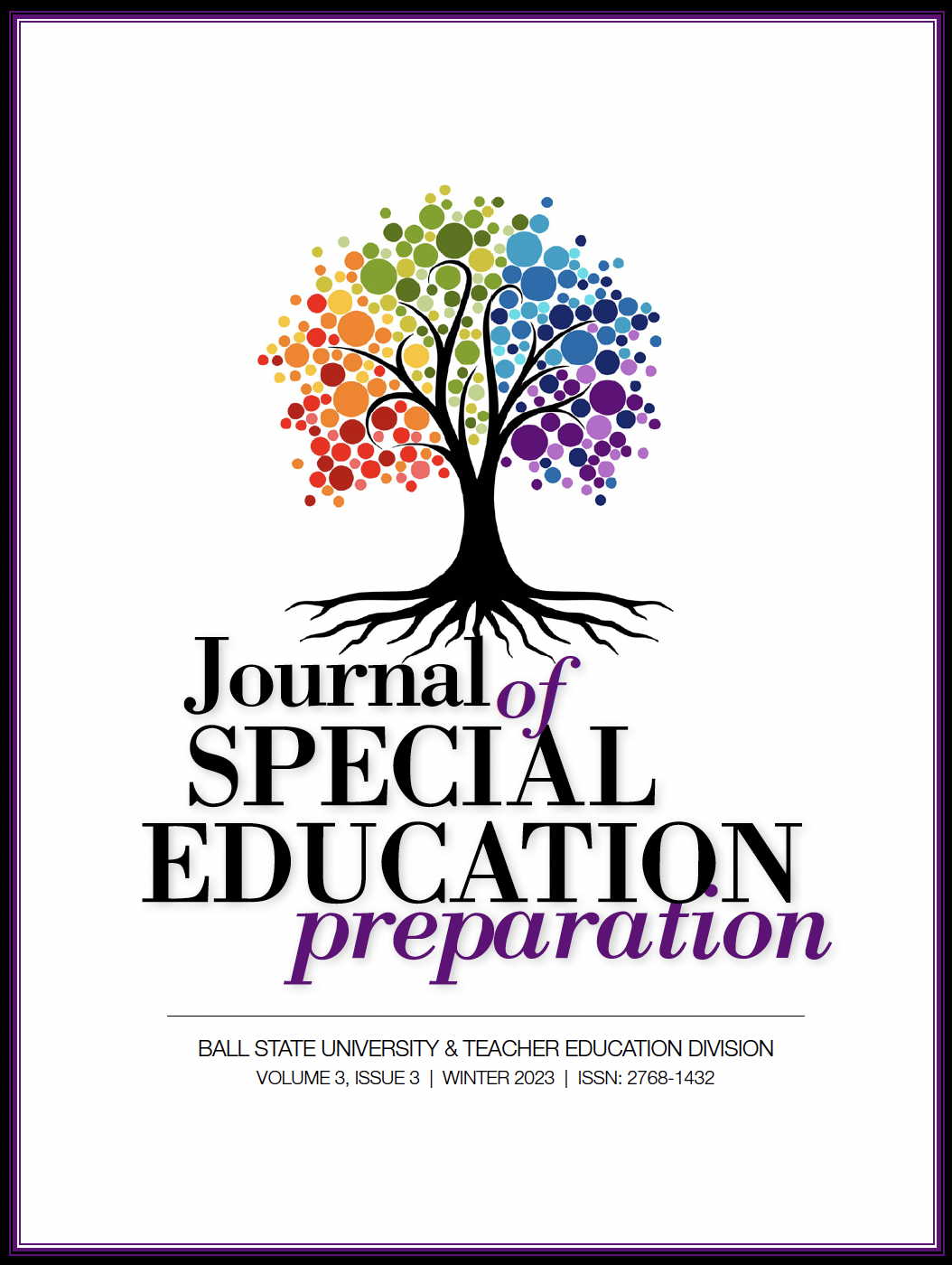
- PDF Damiani et al. (2023)
How to Cite
- Endnote/Zotero/Mendeley (RIS)
Copyright (c) 2023 Michelle Damiani, Casey Woodfield, Brent Elder, Justin Freedman

This work is licensed under a Creative Commons Attribution-NonCommercial-NoDerivatives 4.0 International License .
The Journal of Special Education Preparation ( JOSEP ) is an open-access, peer-reviewed journal that features research-to-practice information and materials for special education faculty in higher education settings. JOSEP brings its readers the latest on evidence-based instructional strategies, technologies, procedures, and techniques to prepare special education teachers and leaders. The focus of its practical content is on immediate application.
ISSN: 2768-1432
JOSEP is published in partnership with and funded by Ball State University Libraries and the Teacher Education Division of the Council for Exceptional Children.

The Role of Special Education Teachers in Promoting an Inclusive Classroom
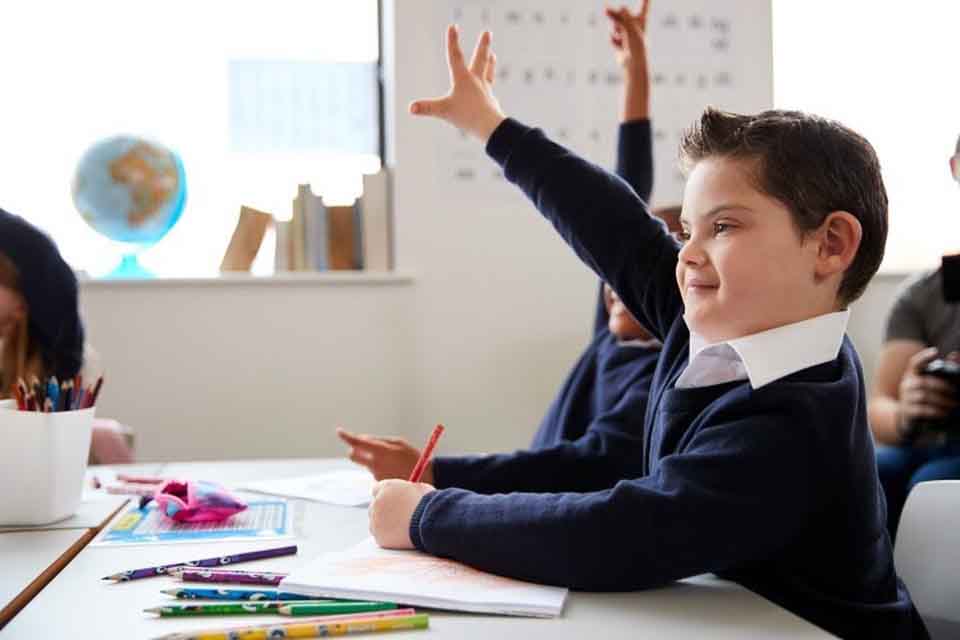
The adoption of inclusive education strategies—where special education students are immersed in classrooms with typically developing peers—has increased rapidly in recent decades. More than 60 percent of students with disabilities spend at least 80 percent of their school day in general education classrooms, according to the US National Center for Education Statistics.
Studies have shown that inclusive learning benefits all students in the classroom by providing thoughtful, personalized instruction and promoting individuality and equity. A student with autism might feel calmer when surrounded by a diverse peer group, while a nondisabled student might learn how to form positive relationships with a greater variety of children.
Establishing a successful integrated learning environment is a complex task involving teachers, administrators, and families. Special education and general education teachers often work together to develop a curriculum and create a positive student culture. In an inclusive classroom, special education teachers have the essential role of ensuring that students with disabilities or special needs receive a quality education.
Why Adopt Inclusive Learning?
The Individuals with Disabilities Education Act (IDEA) states that students with individual education plans (IEPs) must be educated in the least-restrictive environments (LREs) available. Under IDEA, inclusive education (or mainstreaming) has become a standard operating procedure for US public schools. Students with IEPs can range from individuals with Down syndrome or forms of autism to those with speech impediments or dyslexia—all of which require varying levels of support.
Under IDEA, if a differently abled student’s needs can be met in a general classroom, with or without the support of a special education teacher or paraprofessional, they must be educated in that environment. When needs are not fully met in a general classroom, some students spend part of their days in a resource room or in pullout sessions, while others are educated entirely in a special education classroom.
While there is some debate about whether inclusive instruction is the best way to serve students with disabilities, there is mounting evidence that inclusive learning improves educational outcomes. Inclusive educational settings lead to stronger math and reading skills, higher attendance and graduation rates, and fewer behavioral problems, according to an evaluation of more than 280 studies from 25 countries by Abt Associates. In addition to promoting academic success for students with disabilities, inclusive learning can help improve social cognition in typically developing students.
Role of Special Education Teachers in Inclusive Classrooms
For inclusion to show positive benefits, the learning environment and instructional models must be carefully established to provide strong learning opportunities for all students. Special education and general education teachers must have mutual respect and open minds toward the philosophy of inclusion, as well as strong administrative support and knowledge of how to meet the needs of students with disabilities. The involvement of a special education teacher is crucial to the success of a combined learning environment in a number of areas:
Curriculum Design
Special education teachers help craft the lessons for inclusive classrooms to ensure that the needs of students with disabilities are considered. Teachers may work together to develop a curriculum that is accessible to all students, or the special education teacher might make modifications to the general education teacher’s lesson plans. A special education teacher will also create supplemental learning materials for specific students, including visual, manipulative, text, and technology resources, and determine when one-on-one lessons might be needed.
Teachers must examine students’ strengths, weaknesses, interests, and communication methods when crafting lessons. The students’ IEPs must be carefully followed to meet achievement goals. As many general education teachers have limited training in inclusive learning, it is important for the special education teacher to help the instructor understand why certain accommodations are needed and how to incorporate them.
Classroom Instruction
Many inclusive classrooms are based on a co-teaching model, where both teachers are present all day. Others use a push-in model, where special education teachers provide lessons at certain times during the day. It takes extensive cooperation between general and special education teachers to implement a truly inclusive classroom. Special education teachers often sit with or near students with IEPs to monitor their progress and provide any special instructions or supplemental learning materials. Students require varying levels of individual instruction and assistance, based on their unique needs.
Teachers might also pull students out of the classroom for one-on-one lessons or sensory activities, or arrange for time with counselors, speech therapists, dyslexia coaches, and other specialized personnel. Special education instructors may need to make sure that paraprofessionals or therapists are present in the classroom at certain times to assist the students. To help maintain a positive climate, they also might assist the general education teacher in presenting lessons to the entire class, grading papers, enforcing rules, and other classroom routines. General and special education teachers might break classes into smaller groups or stations to provide greater engagement opportunities.
Learning Assessments
Another role of special education teachers in inclusive classrooms is to conduct regular assessments to determine whether students are achieving academic goals. Lessons must be periodically evaluated to determine whether they are sufficiently challenging without overwhelming the students. Students should gain a feeling of self-confidence and independence in general education settings but should also feel sufficiently supported. Special education teachers also organize periodic IEP meetings with each student, their family, and certain staff members to determine whether adjustments need to be made to the student’s plan.
Advocating for Students
Special education teachers serve as advocates for students with disabilities and special needs. This includes ensuring that all school officials and employees understand the importance of inclusion and how to best implement inclusion in all campus activities. Advocacy might include requesting inclusion-focused professional development activities—especially programs that help general education teachers better understand inclusion best practices—or providing information to community members about success rates of inclusive teaching.
Communication with parents is also essential for inclusive classroom success. Families should receive regular updates on a child’s academic, social, and emotional development through phone calls, emails, and other communication means. Parents can help students prepare for classroom routines. Expectations for homework and classroom participation should be established early on.
Learn More About Inclusive Education
Special education and general education teachers can develop a greater understanding of inclusive learning and other progressive teaching methods by pursuing an advanced education degree. American University’s School of Education gives students the skills to drive meaningful change in educational environments. The school’s Master of Education in Education Policy and Leadership and Master of Arts in Teaching degrees prepare teachers to take on transformative leadership roles and create equitable learning environments for all students.
Disproportionality in Special Education: Impact on Student Performance and How Administrators Can Help
What Is Holistic Education? Understanding the History, Methods, and Benefits
What Is Lunch Shaming? How Accessibility to Lunch Impacts Student Learning
Abt Associates, “A Summary of the Evidence on Inclusive Education”
ASCD InService, “Inclusive Classrooms: Looking at Special Education Today”
Houston Chronicle, “The Role of a Special Ed Teacher in an Inclusion Classroom”
EducationNext, “Has Inclusion Gone Too Far?”
Education Week, “Students with Disabilities Deserve Inclusion. It’s Also the Best Way to Teach”
Noodle, “The Benefits of Inclusive Education: What Special Education Teachers Need to Know”
Understood, “4 Benefits of Inclusive Classrooms”
Request Information
- Study Guides
- Homework Questions
Understanding the Impact of Special Education Laws & Inclusion
- Grades 6-12
- School Leaders
NEW: Classroom Clean-Up/Set-Up Email Course! 🧽
Every product is independently selected by (obsessive) editors. Things you buy through our links may earn us a commission.
Paraprofessional Appreciation Day 2024: Celebrating All the Support They Give
Spend a day celebrating these hardworking staff members.
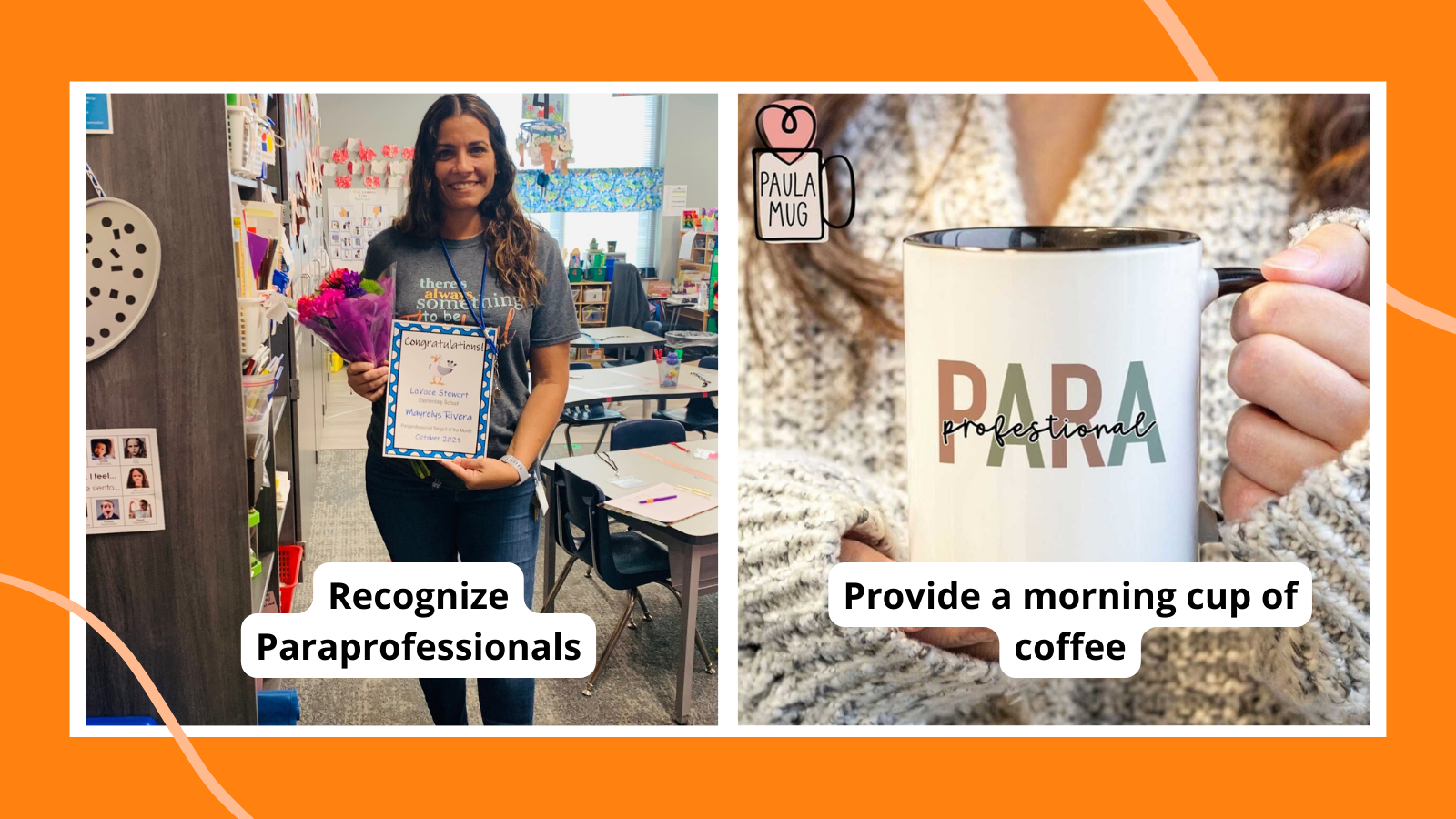
Paraprofessional Appreciation Day 2024 takes place in the first week of April, and it’s the perfect time to recognize the amazing work that paraprofessionals do each day. Check out why we set a day aside for paraprofessionals and ways to recognize the occasion in your classroom or school.
What is Paraprofessional Appreciation Day?
Paraprofessionals, or paras, teaching assistants, or instructional assistants, do a little of everything in schools. They support classes, are assigned to specific students in special education, help with substituting and supporting the general running of the school, and help supervise students.
Parapros are—we’ll say it— not paid enough for the work they do each day. Paraprofessional Appreciation Day is a chance to put them in the spotlight and recognize the dedication they bring to students each day.
When is Paraprofessional Appreciation Day?
Paraprofessional Appreciation Day takes place the first Wednesday in April each year. In 2024, it’s celebrated on April 3.
10 Ways To Celebrate Paraprofessionals
1. bring breakfast.

Start the day off right with coffee, doughnuts, bagels, and more in the staff lounge or delivered individually to your paraprofessionals.
Buy it: Paraprofessional mug at Amazon
2. Celebrate them on social media
Use the hashtag #ParaprofessionalAppreciationDay and post images of your school’s paraprofessionals, their contributions to the school, and how much you love them. Paras are often unsung heroes, working behind the scenes and not as visible to parents as teachers and administrators. Use April 3 (and all of April) to sing their praises!
3. Write thank-you cards
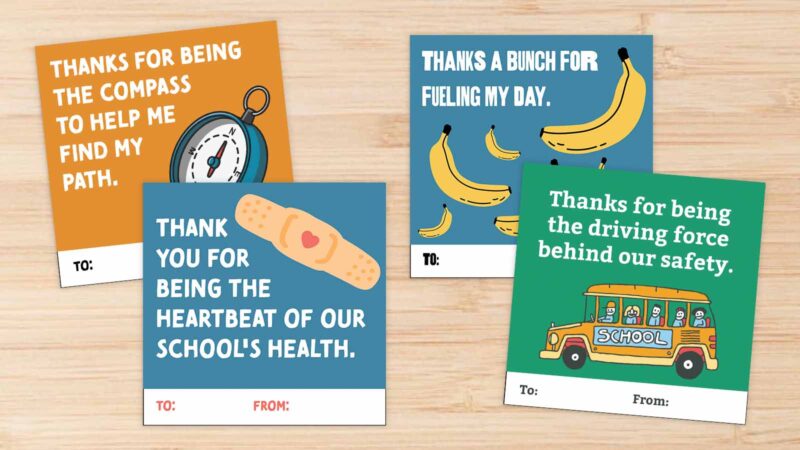
Just like teachers, paraprofessionals appreciate a note of appreciation and thanks for all they do. Customize thank-you notes with signatures from students and staff.
Get it: Free Printable School Support Staff Thank-You Cards at We Are Teachers
4. Host a celebration lunch
Host a lunch for all the paraprofessionals in your school. Give them time in the day to meet together, socialize, and enjoy pizza, fried chicken, or another local favorite.
5. Find the perfect gift
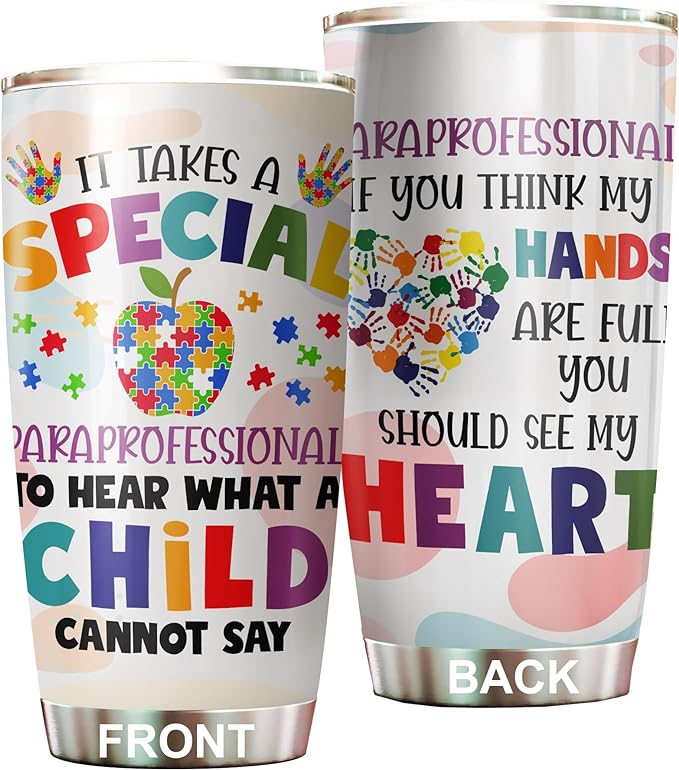
A new tumbler that holds hot coffee or cold soda is a welcome treat.
Buy it: Paraprofessional Tumbler at Amazon
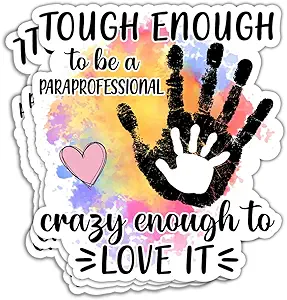
Computer stickers declare how much they love their job and how tough they are.
Buy it: Stickers at Amazon
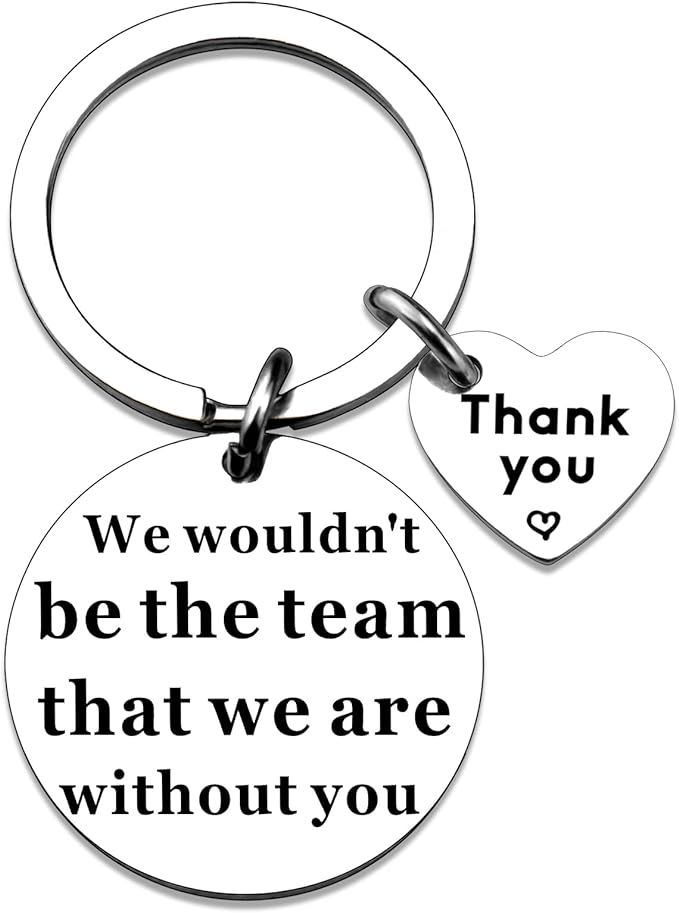
For the paraprofessional who wants a small token of appreciation, or for a small gift that can be given to a team of paras, a key chain is a versatile option.
Buy it: Paraprofessional Key Chain at Amazon
Plus here are even more gift ideas for every paraprofessional in your building.
6. Paraprofessional survival kit
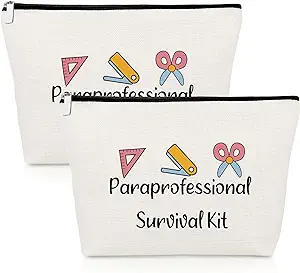
Depending on the paraprofessional, they’ll need different materials to do their job. A special education paraprofessional may need a supply of fidgets or reward tokens, while a first grade teaching assistant may need PBIS tickets and extra pencils. Stock your favorite paraprofessional’s survival kit with just what they need.
Buy it: Paraprofessional survival kit bag at Amazon
7. Create a wooden desk sign
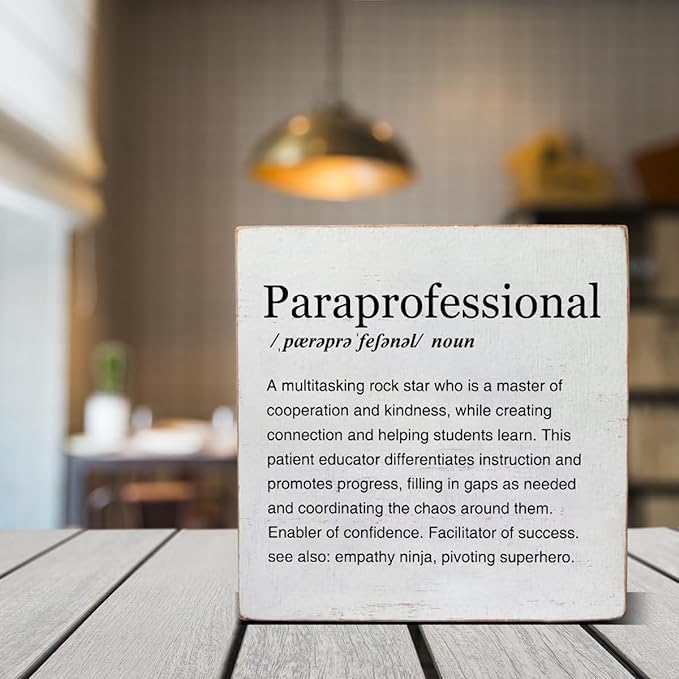
Let everyone know what your awesome paraprofessional does all day with a desk sign that sends a clear message. Order this sign, or get a wooden sign, paint it, and have students contribute their thoughts, words, and images to create a custom desk decoration.
Buy it: Desk Sign at Amazon
Buy it: Unfinished Wood Sheets at Amazon
8. Invest in paraprofessionals
Find professional development opportunities for paraprofessionals to advance their skills and provide those, not just on Paraprofessional Appreciation Day but all year long. Some paraprofessionals may want to gain the credentials to be teachers, but others may have different goals, so find out what each paraprofessional’s goals are and provide PD that fits their needs. The benefit: They’ll have even more skills and knowledge to contribute.
9. Recognize their contributions
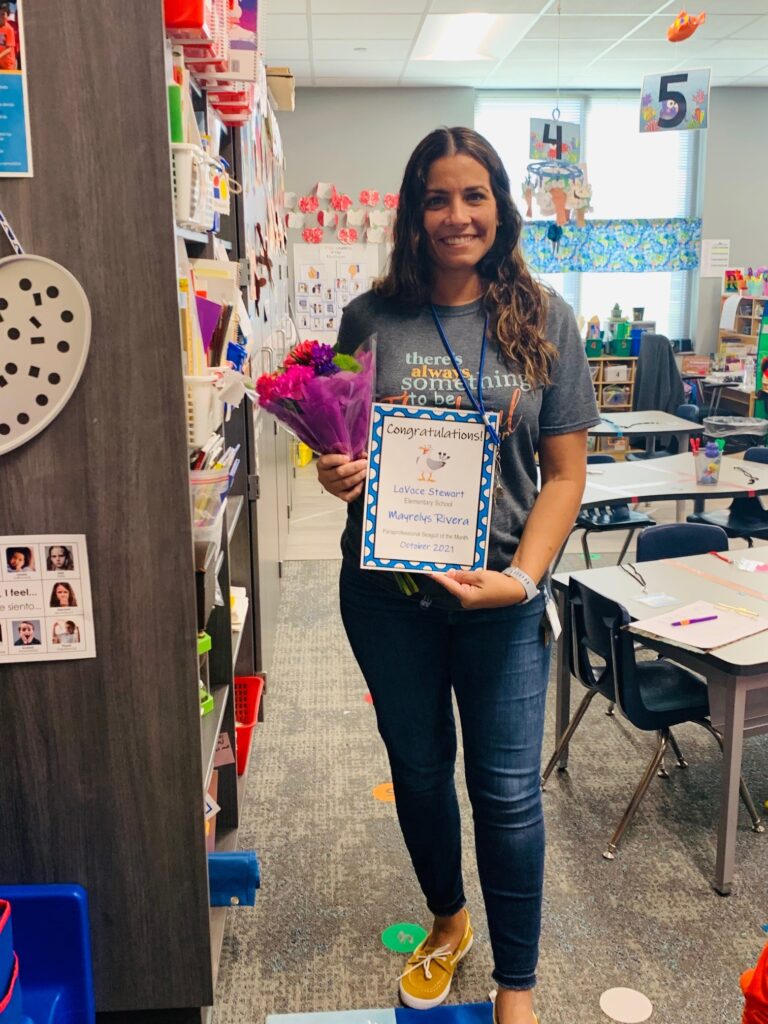
Take time during a staff meeting or special event to recognize the paraprofessionals in your building. Pass out plaques or certificates or create a presentation with information about how each contributes, and include student quotes and observations to make it extra personalized.
10. Decorate the halls

Turn the hallways into a celebration of your paraprofessionals. Have each classroom decorate their bulletin board with thank-yous, take time to say thank you, and give students time to thank your paraprofessionals.
How are you celebrating Paraprofessional Appreciation Day 2024? Share in the We Are Teachers HELPLINE group on Facebook.
Plus, check out a teacher’s guide to working with paraprofessionals . .
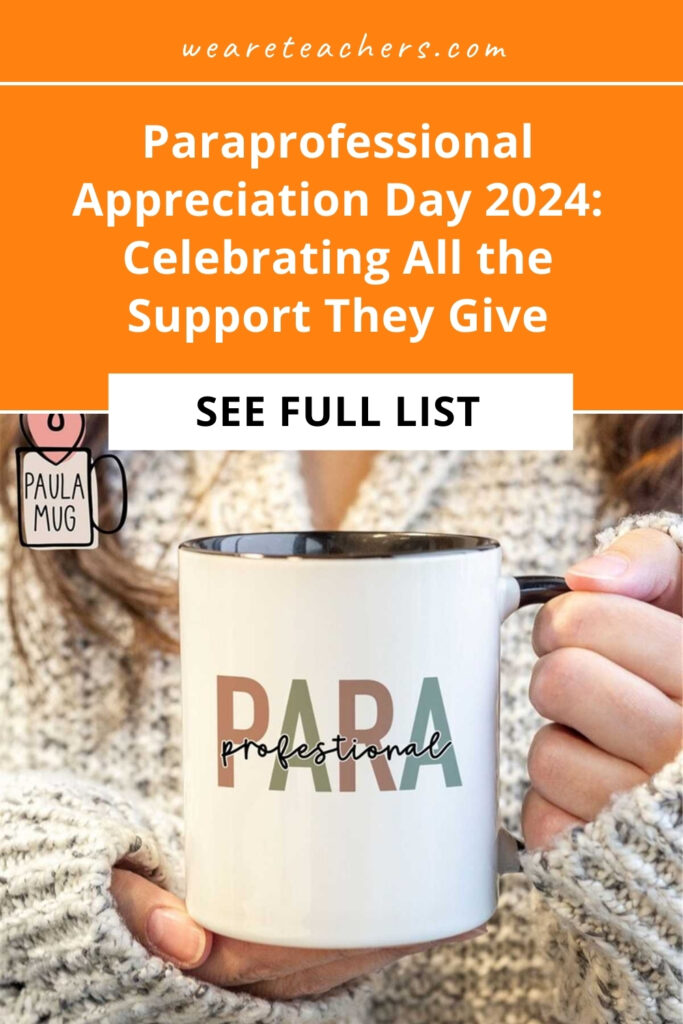
You Might Also Like

8 FREE Kindness Posters to Help Spread the Love in Your Classroom
Because kindness matters most of all. Continue Reading
Copyright © 2024. All rights reserved. 5335 Gate Parkway, Jacksonville, FL 32256
NASET.org Home Page
Exceptional teachers teaching exceptional children.
- Overview of NASET
- NASET Leadership
- Directors' Message
- Books by the Executive Directors
- Mission Statement
- NASET Apps for iPhone and iPad
- NASET Store
- NASET Sponsors
- Marketing Opportunities
- Contact NASET
- Renew Your Membership
- Membership Benefits
- Frequently Asked Questions
- Membership Categories
- School / District Membership Information
- Gift Membership
- Membership Benefit for Professors Only
- NASET's Privacy Policy
- Forgot Your User Name or Password?
- Contact Membership Department
- Resources for Special Education Teachers
- Advocacy (Board Certification for Advocacy in Special Education) BCASE
- Board Certification in Special Education
- Inclusion - Board Certification in Inclusion in Special Education (BCISE) Program
- Paraprofessional Skills Preparation Program - PSPP
- Professional Development Program (PDP) Free to NASET Members
- Courses - Professional Development Courses (Free With Membership)
- Forms, Tables, Checklists, and Procedures for Special Education Teachers
- Video and Power Point Library
- IEP Development
- Exceptional Students and Disability Information
- Special Education and the Law
- Transition Services
- Literacy - Teaching Literacy in English to K-5 English Learners
- Facebook - Special Education Teacher Group
- NASET Sponsor's Products and Services
- ADHD Series
- Assessment in Special Education Series
- Autism Spectrum Disorders Series
- Back to School - Special Review
- Bullying of Children
- Classroom Management Series
- Diagnosis of Students with Disabilities and Disorders Series
- Treatment of Disabilities and Disorders for Students Receiving Special Education and Related Services
- Discipline of Students in Special Education Series
- Early Intervention Series
- Genetics in Special Education Series
- How To Series
- Inclusion Series
- IEP Components
- JAASEP - Research Based Journal in Special Education
- Lesser Known Disorders
- NASET NEWS ALERTS
- NASET Q & A Corner
- Parent Teacher Conference Handouts
- The Practical Teacher
- Resolving Disputes with Parents Series
- RTI Roundtable
- Severe Disabilities Series
- Special Educator e-Journal - Latest and Archived Issues
- Week in Review
- Working with Paraprofessionals in Your School
- Author Guidelines for Submission of Manuscripts & Articles to NASET
- SCHOOLS of EXCELLENCE
- Exceptional Charter School in Special Education
- Outstanding Special Education Teacher Award
- Board Certification Programs
- Employers - Job Posting Information
- Latest Job Listings
- Professional Development Program (PDP)
- Employers-Post a Job on NASET
- PDP - Professional Development Courses
- Board Certification in Special Education (BCSE)
- Board Certification in IEP Development (BCIEP)
- NASET Continuing Education/Professional Development Courses
- HONOR SOCIETY - Omega Gamma Chi
- Other Resources for Special Education Teaching Positions
- Highly Qualified Teachers
- Special Education Career Advice
- Special Education Career Fact Sheets
- FAQs for Special Education Teachers
- Special Education Teacher Salaries by State
- State Licensure for Special Education Teachers
- Utilization of Paraprofessionals in Special Education: Challenges and Benefits
By Jeanne Dagna, Ed.D. Immaculata University
This issue of NASET’s Working with Paraprofessionals in Your School series was written by Jeanne Dagna, Ed.D.. The paper explores the benefits and challenges of utilizing paraprofessionals as support for students in both general and special education classroom settings. Etscheidt (2005) expounded upon the concerns that, despite the wide staffing use, paraprofessionals are extremely under-trained and lack the formalized training necessary for the roles they are asked to perform. Giangreco, Suter, and Doyle (2010) contend that the unintended negative outcomes of using paraprofessionals in the classroom often out-weigh the potential benefits. Myriad legal cases discussed the ways in which the use of paraprofessionals can be legally challenged and shared the wide-range of concerns related to the use of paraprofessionals to support students in general and special education. Although articles vary regarding the levels of support and/or concern for utilizing this staffing method, most concur that if utilized carefully and reassessed often, these paraprofessional supports can prove beneficial.
NASET Members - Login to access this issue of:
Naset's working with paraprofessionals in your school, publications.
- Introduction to Working With Paraprofessionals In Your School
- The Paraprofessional and Supervision
- Team Building: Working with a Paraprofessional
- Communication, Observation, and Feedback
- Solving Performance and Interpersonal Problems
- Related Services Paraprofessionals
- Updated Resource on the Roles and Responsibilities of Paraprofessionals
- Paraeducators’ Preparedness for Success in the Classroom: A Literature Review
- Perspectives on Current Practices and Barriers to Training for Paraeducators of Students with Autism in Inclusive Settings
- Where is the Paraeducator Content in Introductory Special Education Textbooks?
- Applying Empathy Curriculum to Enhance the Role of the Paraprofessional for Students with Multiple Disabilities
©2024 National Association of Special Education Teachers. All rights reserved

- Programs and Projects
- Work with us
- Diversity, Equity, and Inclusion at NTI
- Annual Reports and Financials
Scientific Research Institute for Instruments (NIIP) (Lytkarino)
- Location Moscow Lytkarino, Moscow Oblast
- Type Nuclear-Research and Development
- Facility Status Operational
Want to dive deeper?
Visit the Education Center
Navigation menu
Personal tools.
- View source
- View history
- List of Companies
- Community portal
- Recent changes
- Random page
- What links here
- Related changes
- Special pages
- Printable version
- Permanent link
- Page information
- This page was last edited on 19 October 2023, at 19:28.
- Text is available under GNU Free Documentation License 1.3 ; other licenses apply to photos.
- Privacy policy
- About Camera-wiki.org
- Disclaimers

IMAGES
COMMENTS
1520 Twin Towers East • 205 Jesse Hill Jr. Drive • Atlanta, GA 30334 • www.gadoe.org 9/2021. Special Education Paraprofessional Resources. The responsibilities of special education paraprofessionals vary and can include providing instructional support under the direct supervision of the teacher, modifying materials based on student needs ...
Special education has evolved tremendously over the last several decades, and that evolution has sparked the need for more professionals who can provide specific services to classroom students. A paraprofessional is one of those roles that is somewhat recent with roots in the 1960s. Still, these educators are pivotal to today's general and special education […]
A special education paraprofessional's job description is broad and includes various duties, from providing one-on-one support to helping with everyday tasks. Working one-on-one with students who require more support is one of a special education paraprofessional's main responsibilities. This can be assisting with homework, giving each ...
INTRODUCTION A special education paraprofessional, sometimes called a teacher's aide or assistant, can be a real right-hand man (or woman) to the classroom teacher.Generally speaking, the para provides support to the teacher and especially to students with disabilities in the classroom who need modified instruction or assistance, as keeping with their Individualized Education Program (IEP).
In essence, a special education paraprofessional does more than meet the eye. This important role bridges the gap between can't and can, potential and reality. It's about inclusion, engagement and equipping our students for success in and out of the classroom. Importance of Special Education Paraprofessionals in the Education Setting
Paraprofessionals are essential in helping students with special needs access the general education curriculum and receive the individualized attention they need. This updated edition of Inclusion: An Essential Guide for the Paraprofessional answers paraprofessionals' most common questions and provides extensive strategies for all content areas.
The Paraprofessional's Handbook for Effective Support in Inclusive Classrooms Corwin Press This text carefully addresses the difficulties encountered by teaching or classroom assistants working with children with pervasive developmental disorder, autism and Asperger syndrome. Paraprofessionals in the Classroom Routledge.
Core Competency Area 3: Special Education Services and Supports in the Learning Environment. Paraeducators understand services and supports for students with disabilities is based on the federal law for the inclusion of students with disabilities adhering to the guiding principles of free and appropriate public education (FAPE), least ...
In this fully online, on-demand program designed for special education teachers, special education administrators, and building/district administrators, you'll get evergreen strategies to help enhance the support provided to the paraeducators you work with. ... Promoting Inclusive Practices in Education: Bridging Gaps and Fostering ...
Paraprofessional Skills Preparation Program (PSPP) The Pressing Need for Qualified Paraprofessionals in Schools. The National Association of Special Education Teachers (NASET) and the American Academy of Special Education Professionals (AASEP) recognize the increasing need for qualified special paraprofessionals in schools.In order to enhance this area of concern, they have created a ...
Inclusive Education Paraprofessional Series. This professional development series is designed to provide paraprofessionals with effective strategies to help them better support students with disabilities in inclusive classrooms. The content is organized into five modules that are aligned to the six professional standards for paraeducators as ...
This guide for paraprofessionals offers practical guidelines for assisting in inclusive classrooms. The guide presents an overview of the special education system and an assortment of strategies and ideas to implement in the general classroom environment. An introduction explains the philosophy of inclusion and differentiates it from mainstreaming.
Paraprofessionals serve a critically significant role on educational teams, yet often receive the least amount of training among educational professionals. This article details an online paraprofessional learning series created by a team of special education faculty. The professional development series draws on a disability studies in education (DSE) approach and high leverage practices to ...
Karen H. Jones, EdD, is associate professor of vocational special needs at the University of Georgia. She is director of a grant funded by the Office of Special Education and Rehabilitative Services to prepare paraprofessionals for employment in programs that serve at-risk students.
A one-on-one or instructional aide is a type of paraprofessional that is assigned to a specific student, typically a student who has a disability. If a child requires one-on-one assistance to learn in the school setting and it's written into their IEP, then the paraprofessional assigned to them is there to help that student throughout the day ...
Core Competencies for Special Education Paraeducators (CEC, 2022) to ensure that all school personnel, including administrators, teachers, and paraeducators have a clear understanding of the knowledge and skills that are
INTRODUCTION. The increased use of paraprofessionals in a variety of educational settings has resulted in the need for teachers and other educational professionals (nurses, speech-language pathologists, occupational/physical therapists) to assume the tasks of supervising these individuals. Being a qualified educational professional, however ...
The adoption of inclusive education strategies—where special education students are immersed in classrooms with typically developing peers—has increased rapidly in recent decades. More than 60 percent of students with disabilities spend at least 80 percent of their school day in general education classrooms, according to the US National ...
Video Lecture and PowerPoint Presentation: This lecture is going to cover many different areas that you need to understand when educating children with special needs as a paraprofessional. The first part of the lecture will address where students can be educated (Least Restrictive Environment) and the written plan that explains the special education and related services they will be provided ...
Inclusion can help prevent neglect of special education students giving them more support they need and more supervision. In inclusion classroom, general education and special education work together in the same classroom. This gives special education students a chance to see and interact with general education students.
A special education paraprofessional may need a supply of fidgets or reward tokens, while a first grade teaching assistant may need PBIS tickets and extra pencils. Stock your favorite paraprofessional's survival kit with just what they need. Buy it: Paraprofessional survival kit bag at Amazon. 7. Create a wooden desk sign Amazon
192. v. t. e. This is a list of the administrative and municipal divisions of Moscow Oblast, a federal subject of Russia . Moscow Oblast is located in the Central Federal District of Russia, and surrounds Moscow, the capital of Russia. While Moscow hosts the majority of the government bodies of the oblast, it does not officially serve as the ...
Lytkarino Lytkarino is a town in Moscow Oblast, Russia, located on the left bank of the Moskva River 6 kilometers southeast of Moscow.Population: 65,212 ; 55,237 ...
The paper explores the benefits and challenges of utilizing paraprofessionals as support for students in both general and special education classroom settings. Etscheidt (2005) expounded upon the concerns that, despite the wide staffing use, paraprofessionals are extremely under-trained and lack the formalized training necessary for the roles ...
This page is part of the Facilities Collection.. Established in 1956, NIIP designs and tests instruments and electronic equipment to measure radiation, creates physical and mathematical models to determine the effects of varying types of radiation exposure on equipment, develops automated instruments for taking measurements during radiation research, and conducts surveys of ionizing radiation ...
LZOS (Лыткаринский завод Оптического Стекла , Lytkarino Zavod Optychisovo Sticklo) is an optical factory in Lytkarino, in the Moscow Oblast of Russia. It was at one time part of the same production unit as KMZ, and made lenses for KMZ Zenit and Zorki cameras. However, photographic lenses were only ever a small part of the work of the factory.